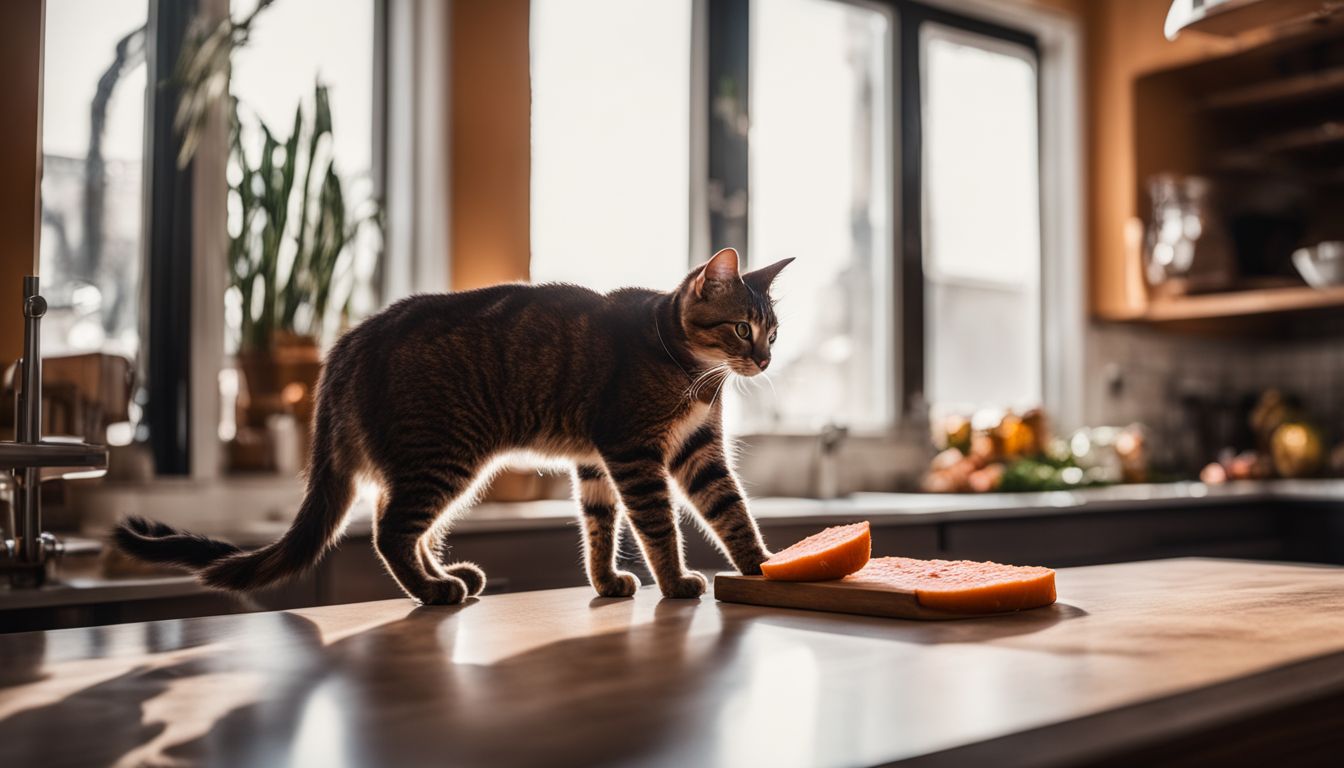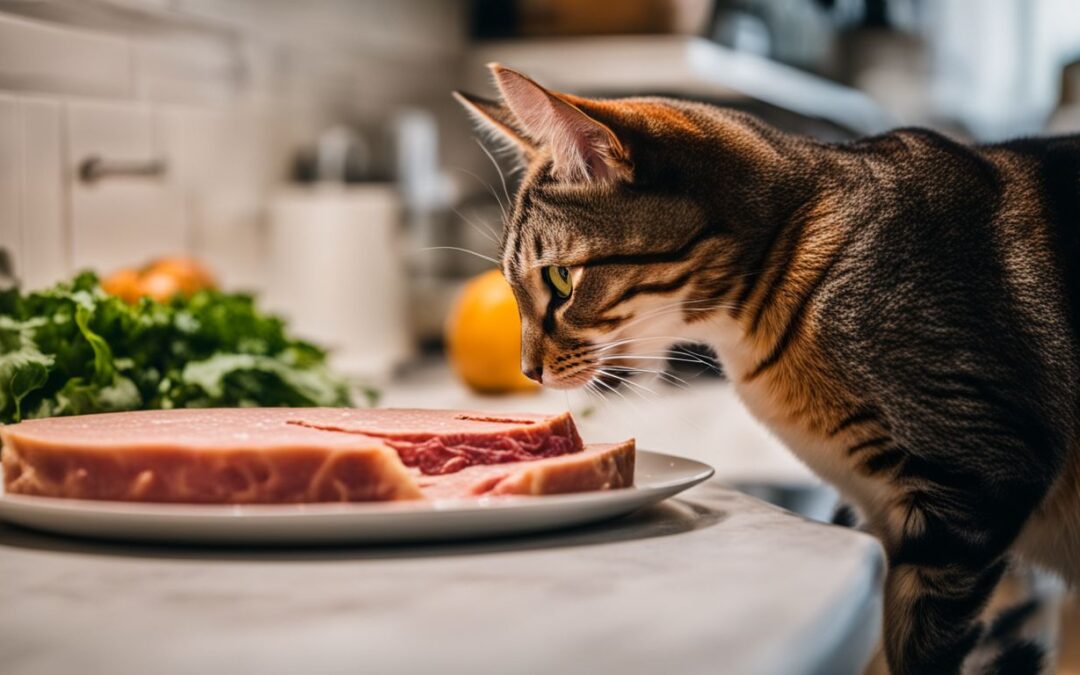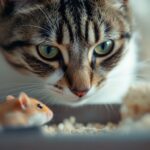Ever caught yourself in the midst of making a sandwich, wondering if it’s alright to toss a slice of bologna your cat’s way? You’re not alone. I’ve scratched my head over this too and delved into the facts about our furry friends indulging in this particular deli choice.
Join me as we unpack the details on bologna’s compatibility with kitty diets – from what exactly is lurking within that seemingly harmless meat round to just how much (or little) should make its way into their bowl.
Stay tuned; you’re bound to find this enlightening!
Key Takeaways
- Bologna has salt, sugar, and garlic which are bad for cats. Too much can make them sick or even lead to death.
- Giving cats bologna often can cause health problems like obesity, high blood pressure, and heart issues.
- While a little bit of bologna as a treat is okay, it’s best to feed cats food that is good for them instead.
Bologna Ingredients and Their Impact on Cats

Bologna is full of salt, sugar, and garlic. These can be harmful to cats in large amounts.
Salt
Salt in bologna can be a big problem for cats. It’s like giving them way too much of what they only need a little. Imagine eating a whole bag of chips by yourself. Sounds fun, right? But then you feel sick afterward.
That’s how cats feel with too much salt from bologna. Their bodies can’t handle it well, leading to things like throwing up and feeling extra thirsty – just the start of their troubles.
Eating bologna often or in big bits means lots of salt, which isn’t good for our furry friends. This can lead to salt poisoning – yikes! Signs that your cat ate too much include vomiting, diarrhea, walking funny, and seeming very tired.
If it gets really bad, we’re talking kidney issues and even death, which is super scary to think about! So yeah, keeping those salty snacks away from kitty is the best move for their health.
Sugar
So, bologna has sugar in it. That might sound okay at first. After all, a little sweetness hasn’t hurt anyone, right? Well, for our feline friends, it’s a bit of a different story.
Eating too much sugar can make cats put on extra pounds. Sure, we love our cats chunky – more to cuddle! But this weight gain isn’t good for them. It’s like when I eat too many cookies and notice my jeans are tighter.
Except for cats, that extra weight can lead to some pretty serious problems down the line.
Think about it – obesity in cats is no small matter. We’re talking big risks here: diabetes with its blood sugar roller coasters; heart disease making their tiny hearts work harder than they should; even arthritis making every jump onto the sofa painful…
The list goes on! So you see, while that slice of bologna might seem harmless—and delicious—to your cat, those hidden sugars could be setting them up for trouble later on with their health.
And trust me; keeping a cat healthy is way easier than trying to get them back into shape once they’ve gone down that road.
Garlic
Moving from sugar, let’s talk about another ingredient in bologna that can be harmful. Garlic might give food a tasty kick for us humans, but it’s a whole different story for our feline friends.
This common kitchen herb can cause serious health issues in cats, even if they eat just a little bit of it. For starters, garlic contains compounds that are toxic to cats and can lead to oxidative damage in their red blood cells.
This means those cells could burst or not work right. When this happens, the cat might become anemic, which is when they don’t have enough healthy red blood cells to carry oxygen around their body properly.
In really bad cases, this condition could get so severe that the cat might need a blood transfusion just to stay alive. Just thinking about my furry friend going through something like that makes me double-check everything I feed them!
Potential Risks of Cats Eating Bologna

Feeding cats bologna might seem harmless, but it poses serious risks to their health. Bologna contains high levels of salt and fat, which can lead to salt poisoning and obesity in felines.
Salt consumption above the safe limit can cause dehydration, vomiting, diarrhea, tremors, seizures, and even death in extreme cases for our whiskered companions. Additionally, excess fat intake from bologna may result in pancreatic issues or fatty liver disease in cats.
Moreover, many bolognas contain garlic or onion powder which are toxic to cats’ red blood cells — even small amounts could be dangerous. The symptoms of garlic toxicity include lethargy, vomiting, elevated heart rate (tachycardia), respiratory distress (dyspnea), weakness on the hind legs (paralysis), pale gums (pallor), drooling and raised body temperature (hyperthermia).
Therefore it’s important to avoid giving them any food containing these ingredients if you wish your furry pals a long and healthy life. Instead of risking their well-being with processed meats like bologna.
4. Nutritional Benefits of Bologna for Cats.
Nutritional Benefits of Bologna for Cats
While bologna is not the healthiest food option for cats, it does offer some nutritional benefits. Bologna can provide protein, which is vital for your feline friend’s muscle strength and overall well-being.
Additionally, bologna contains essential nutrients such as vitamins and minerals that can contribute to a cat’s balanced diet. However, these benefits must be weighed against the potential risks associated with high salt content and fatty meats present in bologna.
Therefore, if you choose to give your cat bologna as an occasional treat, it should only be in small amounts to avoid any adverse effects on their health.
Appropriate Quantities of Bologna for Cats
Feeding bologna to cats should be limited to small, infrequent portions as an occasional treat. Although cats can eat bologna in small amounts, regular consumption can lead to health issues such as obesity and high blood pressure.
It’s important to remember that even though cats may enjoy the taste of bologna, it should only be given sparingly due to its high salt and fat content. Moderation is key when giving bologna to your feline friend.
It’s crucial for cat owners to understand that while a small piece of bologna might seem harmless, the cumulative impact of regularly feeding it could harm their pet’s health. Always consult with a vet before introducing new foods into your cat’s diet, including processed meats like bologna.
Remember that the primary source of nutrition for cats should come from balanced cat food, not human foods like bologna.
Safe Preparation Methods for Giving Bologna to Cats
When it comes to treating your feline friend with bologna, it’s crucial to prioritize their safety and well-being. Here are some safe preparation methods to consider:
- Choose low-sodium or no-salt-added bologna options to minimize the impact of excessive salt on your cat’s health.
- Opt for minimally processed bologna without added sugars, as excessive sugar intake can lead to health issues for cats.
- Ensure that the bologna does not contain garlic or onion, as these ingredients can be harmful to cats.
Remember that moderation is key when it comes to feeding bologna to cats. While occasional small portions can be safe, it’s important to prioritize healthier meat options like chicken or turkey in their diet.
Alternatives to Bologna: What Human Meats Are Safe for Cats?
When it comes to feeding your feline friend, it’s important to choose safe and healthy options. Here are some alternatives to bologna that are safe for cats:
- Cooked Lean Meats: Beef, turkey, chicken, liver, and lamb are excellent options. These meats provide essential nutrients and are safe for your cat when cooked thoroughly.
- Commercially Available or Homemade Cat Treats: There are many specially formulated treats available that cater to a cat’s nutritional needs. You can also make homemade treats using vet-approved recipes.
- Avoid These Human Foods: While some human foods may be safe for cats in small quantities, it’s essential to avoid items such as onions, garlic, chocolate, and grapes as they can be toxic to cats.
- Veterinary-Approved Diet: Consult with a veterinarian or a veterinary nutritionist to create a bespoke diet plan tailored towards your cat’s specific nutritional requirements.
- Taurine-Rich Foods: Ensure your cat’s diet includes taurine-rich foods such as chicken, turkey, and fish which are essential for their heart health.
- Hydrating Foods: Incorporate wet cat food into your cat’s diet as it helps keep them hydrated while providing essential nutrients.
Remember that the key is moderation – any new food should be introduced gradually and monitored for any adverse reactions or digestive upset.
Frequently Asked Questions about Cats and Bologna
Transitioning from discussing safe human meats for cats in the previous section, let’s address some common inquiries regarding cats and bologna. Here are some frequently asked questions:
- Can cats eat bologna on a regular basis?
- Cats should not consume bologna regularly due to its high salt and fat content, which can lead to health issues such as obesity and kidney problems.
- Feeding bologna to kittens is not advisable as their developing bodies are more sensitive to excessive salt and fat, which can lead to health complications.
- Risks include digestive upsets, pancreatitis due to high-fat content, and toxicity from ingredients like garlic, onions or chives that might be present in certain types of bologna.
- Bologna isn’t a nutritionally beneficial food for cats as it contains minimal essential nutrients required for feline health.
- Bologna should only be given occasionally as a small treat. A tiny piece once in a while won’t harm them, but it shouldn’t become a staple part of their diet.
- If you choose to give your cat a very small piece of plain, unsalted, unseasoned, and unsmoked bologna as an occasional treat, it may be safer. However, it’s better to opt for healthier alternatives like cooked chicken or turkey.
- Safer alternatives include lean meats such as chicken and turkey that offer more nutritional value without the harmful additives found in processed meats like bologna.
These FAQs aim to provide guidance on the complexities surrounding cats consuming bologna and offer tailored advice towards keeping your feline companion healthy and happy without resorting to processed meats with potentially harmful ingredients.
Creative Bologna Treat Ideas for Cats
After answering some questions about bologna and cats, let’s get creative with how we can treat our feline friends to this tasty snack. Here are some fun and safe ways to give your cat a little bologna delight:
- Bologna Puzzle Toy: Wrap small pieces of plain cooked bologna in a puzzle toy for your cat to discover.
- Frozen Bologna Pops: Create frozen bologna popsicles by placing small pieces of bologna in an ice cube tray, filling with water, and freezing.
- Bologna Playtime: Use small pieces of plain cooked bologna as a reward during playtime or training sessions with your cat.
- Bologna Snack Ball: Fill a treat-dispensing ball with tiny chunks of plain cooked bologna for your cat to roll around and enjoy the rewards.
- Bologna Stuffed Toy: Sew a small pocket into a fabric toy and stuff it with tiny pieces of plain cooked bologna for an engaging playtime treat.
Remember, moderation is key when treating your cat!
Conclusion
Cats and bologna don’t make a good pair. The nitrates in bologna can harm cats. Bologna lacks essential nutrients for cats. Feeding it to them regularly could affect their health. It’s best to stick with cat-friendly treats instead.
For more information on what human foods your furry friend can safely enjoy, check out our guide on whether cats can eat Brussels sprouts.
FAQs
1. “Is bologna a good snack for my cat?”
Well, let’s chat about that. Bologna might seem like an easy treat to give your furry friend – I mean, it’s meat, right? But here’s the scoop: bologna is not the healthiest snack for cats. It goes through a lot of processing (think curing and smoking), which adds stuff your cat doesn’t need. And by “stuff,” I’m talking about extra carbs and salt. Cats are more into protein; they’re not big on carbohydrates.
2. “Can bologna make my cat obese?”
Ah, this is a tricky one! So, you know how we sometimes enjoy an extra slice of pizza and then think about hitting the gym… but don’t? For cats, too many treats like bologna can lead to them packing on some unwanted pounds since these snacks are high in calories and not exactly part of their natural diet. Before you know it, your cat could be waddling instead of strutting!
3. “What if my cat accidentally eats some bologna?”
First off—don’t panic! If Mr. Whiskers sneaks a piece of bologna when you’re not looking (“Oops… did I leave that out?”), he’ll probably be fine with just a little taste here or there as long as it’s rare – kind of like how we view eating cake at 2 AM; fun once in awhile but not great as a habit.
4. “Should I talk to someone before giving human food to my pet?”
Absolutely! When in doubt, shout out—to your vet tech or DVM (that’s Doctor of Veterinary Medicine for those who skipped vet school). They’ve got all the knowledge about what foods can cause issues like obesity or even anemia in cats due to certain deficiencies or toxicities from our human food choices (even though mortadella sounds fancy). So yeah, always best to check with them first before sharing your lunch with Fluffy.






